“Do you want to see a deer standing on a bridge looking out over the city skyline?”
I stare blankly back at my best friend, Saeed Jones. I have flown out to his new home in Columbus, Ohio to visit him. To look at him. To laugh with him. And to simply breathe him in after being apart for far, far too long. I’ve been in town less than an hour and we’re trying to figure out where we should walk.
“Or it’s a deer debating whether or not to jump off the bridge. Depends on how you look at it. It’s sort of an eye-of-the-beholder type thing.”
While I am, indeed, intrigued by this deer (which I will shortly learn is a statue of a deer), it’s hard to pay attention to anything other than my desire to pull Saeed close to me and squeeze him until we both pass out.
Instead we set off for the Scioto River, which runs through Columbus, enjoying the riverfront beauty that is the Scioto Mile. We talk, our conversation falling back into an unforgotten rhythm, meandering over and around a plethora of topics both new and old, until we arrive at the Rich Street Bridge. That’s when I see it, off in the distance, a deer leaning on the guardrail and staring out at the water.
The sculpture is part of a city-commissioned art installation by artist Terry Allen, who was inspired by the name of the river itself, “Scioto,” which is derived from the Wyandot people’s word for “hairy deer.”
We cross the bridge to get a closer look at the statue, and I delight in making Saeed pose with the deer like some kind of overbearing theater mom.
On the other side of the bridge we come across two more sculptures by Allen. A deer that is maybe best described as… deerspreading?
And a doe that is doing exactly what one is supposed to do in a public park: lounge around and relax while sending out VIBES.
Having had our full of anthropomorphic deer, Saeed and I proceed on past the National Veterans Memorial and Museum to the Memorial Grove that is found behind the building. The garden is bursting with plants and flowers that are native to the region and, with the smell of blossoming American wisteria on the air, we slowly walk in circles as we continue to talk.
Isaac: What is it about Columbus, Ohio? What drew you here?
Saeed Jones: I visited Columbus twice before I moved here. In 2012, a community group flew me out to do a poetry reading as part of the city’s Pride Month celebrations. And when I arrived here, I was like — Whoa! — I’ve got a lot of sisters here! I have always had a soft spot for queer people and queer communities that aren’t in New York, or Los Angeles, or San Francisco. And then I was like — Oh! These girls are fierce! So that was simply a marvelous time. Then in 2018, you and I came here for a work trip and got to see a lot of the city for the show we were doing. And it was fall. Fall in Columbus is just a wonderful time. Wonderful energy, everyone is out and about. It felt very welcoming, very friendly. People here love to eat, they love to drink, they love to have a good time, and there are a lot of fantastic writers here too. I met Hanif Abdurraqib, I mean I knew him, but I was like, “oh this is your home,” and he was like, “yeah, and Maggie Smith lives here too!” I didn’t know that so many artists were here. So I think I just saw the energy. It felt good. I’d been living in New York for a decade and knew I was going to need to make some changes, both in terms of writing independently, and also — where am I going to live when I do that? And I knew that I could not stay in New York as I was living currently and support myself and my writing in that way… and not lose my mind. So yeah, it just felt right. It felt fun. And it made a lot of sense.
I: How has moving to Columbus affected your writing life?
SJ: I am writing more. It is a more affordable city than other places I’ve lived, so it’s easier to support myself. I’m able to be more selective in what I take on. Which means I have more time. More time to percolate. I have more time to do what I want to do. I’m less stressed out generally speaking in Columbus, so I have time to daydream. So it’s been exciting! As soon as I moved here, the rate of writing, particularly writing poems, sped up.
I: So you’ve been working during the last year?
SJ: It was slow at first. The beginning of the pandemic it was like, uhh… I tried. And it was rarely productive. But in the last three months, four months, a sense of hope on some level has kind of come into the picture. It’s like I’m waking back up.
I: What were or are some of the ways, not just with the last year during the pandemic, but also in general — for me it was walking, that was kind of my response — what are some of the ways you try to cope?
SJ: Again, it’s that flexibility. Being able to say no. I really leaned on that. I was like, I just don’t think I’m going to be working as much. And I really tried to pay attention to how I felt. And often that was — I think I’m just going to be on the couch all day! And trying to be kind to myself about that. I also adopted a lovely little dog, Caesar, a year ago, and, you know, dogs are amazing. But I do think it’s also healthy, it’s good to need to take care of someone or something. To get out of your head and focus on another living being. I can get out and go for a walk with him. I have to feed him. Keep a schedule because of him. It was a lot of patience at first, but I love him so much. Another coping mechanism, especially this past year, was playing video games, particularly in the winter. Playing Assassin’s Creed Valhalla, it was a beautiful lush world, and you could focus on it, and not keep looking out the window and be like, “it’s snowing again”. That was really helpful during the winter months.
I: You were also very active last summer during the protests, and there have been ongoing protests, ongoing issues in Columbus and, of course, throughout the country. What was it like last summer here in Columbus?
SJ: Listen. I understand white supremacy. I think I get the gist. I think it’s important, though, to be reminded that it is systemic violence. It doesn’t matter where you are. And something I’ve said all last year, there’s nowhere in America that you can go and not be in America. I’m going to be myself wherever I am. And often that means police violence and white supremacy are going to be a part of that story no matter how much I love a city. The Columbus Police Department, to me, is very scary. It’s very scary, and I say that as someone who lived in New York City and also found the NYPD very scary. But I think it feels like there’s this dynamic where, one: I think something like eighty percent of the cops here don’t live in Columbus, they live outside of the city, so I think that’s an energy. I don’t think they like the politicians here. They don’t like the mayor, they don’t like the city council. I also don’t think they like a lot of their own police leadership. So going to these protests I just felt like, the cops just seemed like chaos agents. Does that make sense?
I: Completely.
SJ: The one other thing I’d say is — the activists here, the black people here, and the people who care about black people here, are all working extremely hard. And I wish more people who aren’t in Columbus got to see how passionate and sustained and creative the protests and the vigils and the sit-ins are. They’re truly working really, really hard. And I think so often when we talk about police brutality and all of this, it’s like, that is often set aside. But I’m inspired. I think it’s beautiful, it’s creative, it’s sustained. The activists and organizers here in Columbus, Ohio do not give up. Last summer there were protests — and now even — there have been protests where the protesters, they’ll march for miles and miles and miles to prove their point. It’s hot here in Columbus in the summer, and just seeing that commitment, being there and witnessing it and participating in it… it’s one of the few things that kind of gives me hope about this, because it can all be so disheartening.
I: Disheartening is certainly the word for it. Ok, one last question. You recently wrote a beautiful piece about friendship for The Cut. So, how much did you miss me?
SJ: I missed you a lot! Tremendously!
I: You can expand on friendship in general. You don’t need to sit here and talk about how great I am.
SJ: I moved here in October of 2019, and then I went on the book tour. So, I was away, and then basically I got done with the book tour and it was like, deep winter, and then right in the beginning of February when I was like, okay it’s time for normal life, Plan a trip to New York to see my friends and all that kind of stuff. And right when I was ready to do all that, lockdown happened. So it meant that not only had I not seen my friends for a year, I actually hadn’t seen them for a year and a season. Even here. I have friends in Columbus who live a five minute walk away and the pandemic — they might as well have been in New York, or in Spain. It’s a kind of grief, you feel. And what is grief? It’s gratitude — grief is a painful kind of gratitude. You’re made to feel grateful for loss and it’s so intense because you realize when someone is taken away from you or you can’t get to them, all of the different ways they colored your life. And that gratitude is abrupt and bracing. That’s what it felt like. Wouldn’t it be nice to go do this, wouldn’t it be nice to go do that. But now, I am vaccinated, and the weather is nice. I want to get out and get about. And obviously you’re here, and — it’s the other side of the gratitude. The fun side of the gratitude, where it’s like, let me act upon that gratitude, and let me show how much I love my friends, because now we know that, like, wow, we can’t just like, take hanging out in a dive bar for granted.
I: It’s not guaranteed.
SJ: It’s not guaranteed.
I: Amen. I missed you too. It’s really good to see you.
The next morning I wake up early and walk down W 2nd Avenue, which is beautiful and made of brick, all the way to the Olentangy River. I stroll along the river’s shore and follow it until it meets the Scioto, passing a family of Canadian Geese, two birds with three goslings, along the way.
The bridges here aren’t as polished or new as the ones downtown, but their elegance persists. In a way they seem to blend in with the landscape, as if they are as much a part of my surroundings as the trees, and plants, and rivers.
As the wind picks up I watch a maple seed, a samara, helicopter down in front of me. Without thinking I grab the spinning seed out of the air, something I haven’t done since I was a child. I feel lucky. To have caught the seed, to be here in Ohio with my friend, or simply to be here at all. Every day above ground. I make a small wish and then throw the seed up into the air, watching it spiral down again towards the water.
I exit away from the river at North Bank Park Pavilion and walk up Neil Avenue as it begins to rain. Soon I’m soaked through despite trying to take cover under a tree, but I don’t mind. The air is still warm, and an elderly woman sitting in the window of a nursing home waves at me as I walk by. I wave back and give a shrug at the rain, which makes her laugh. The blossoms are out and I’m headed back to exactly where I want to be. With my best friend.





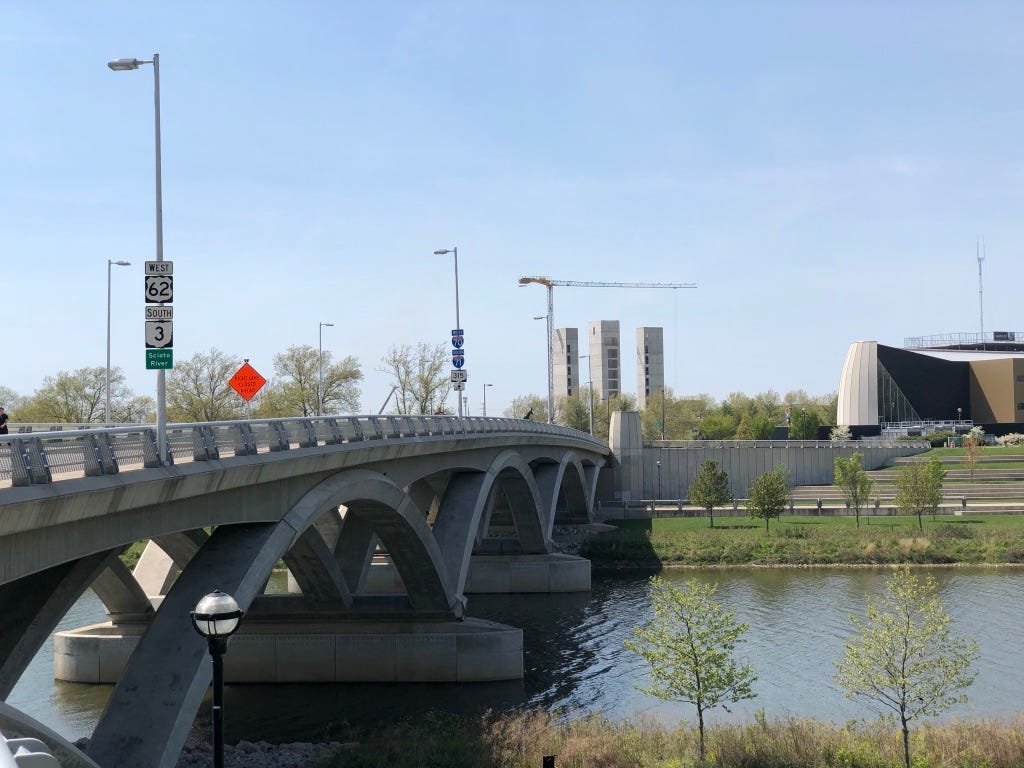

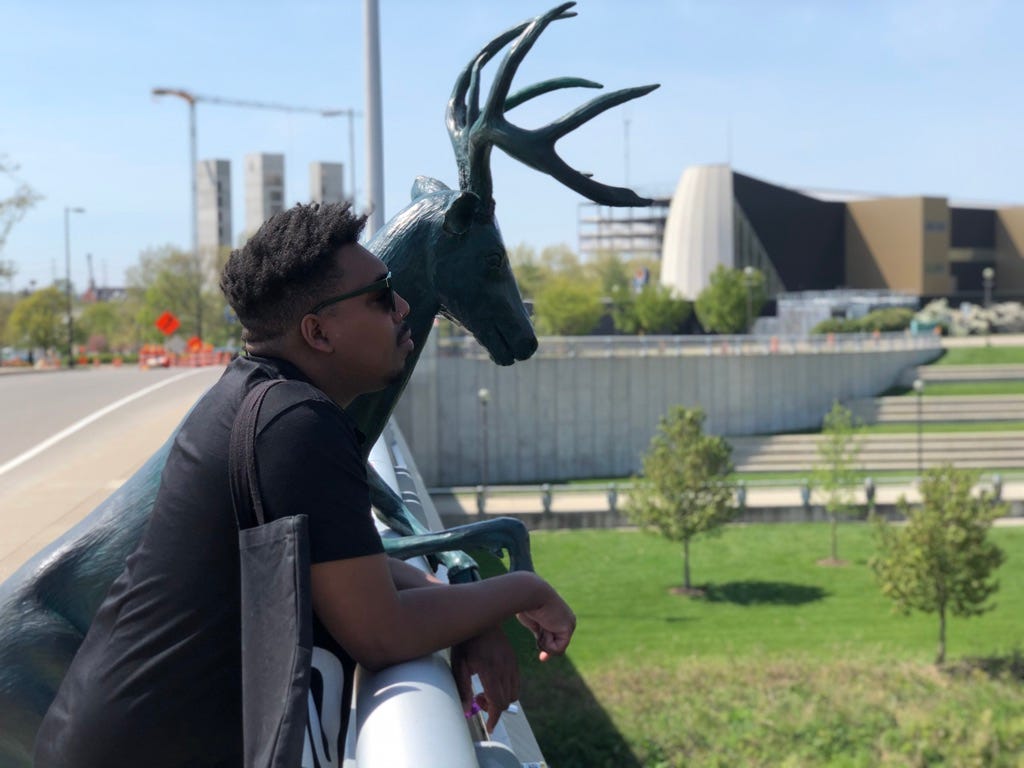
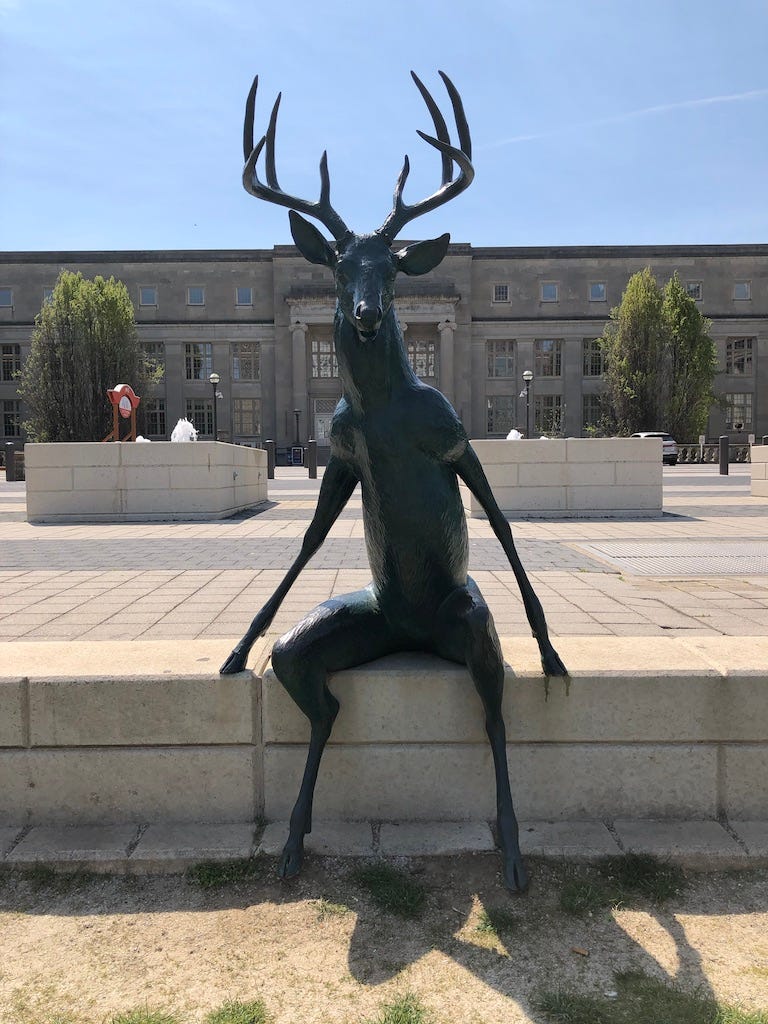
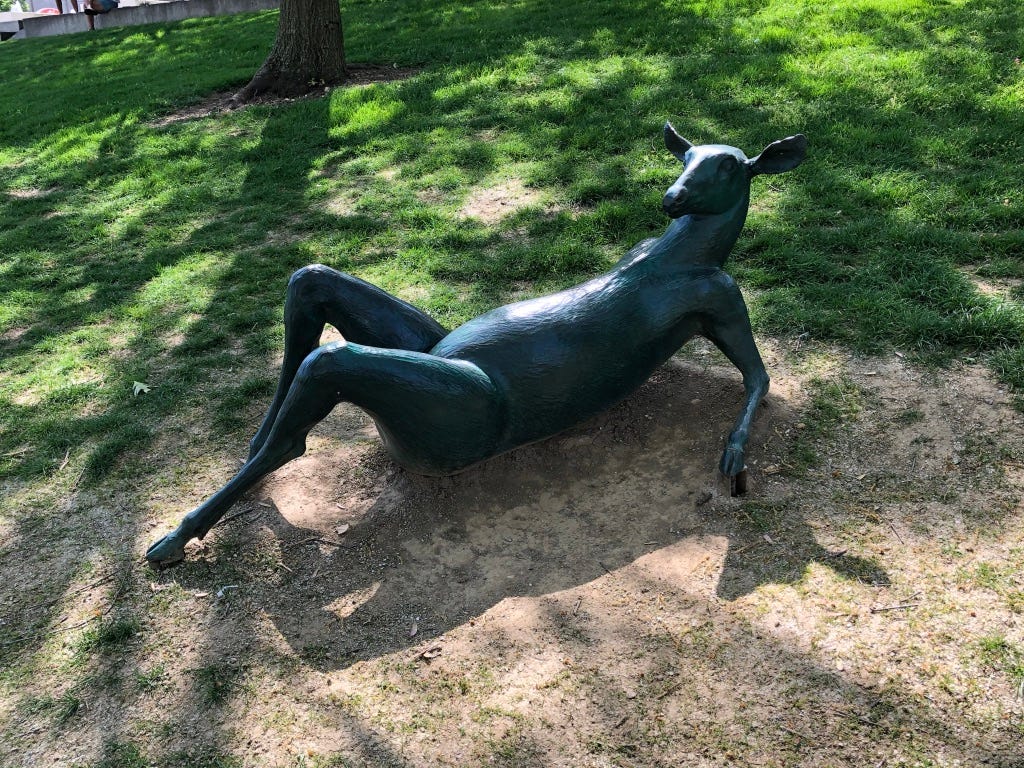
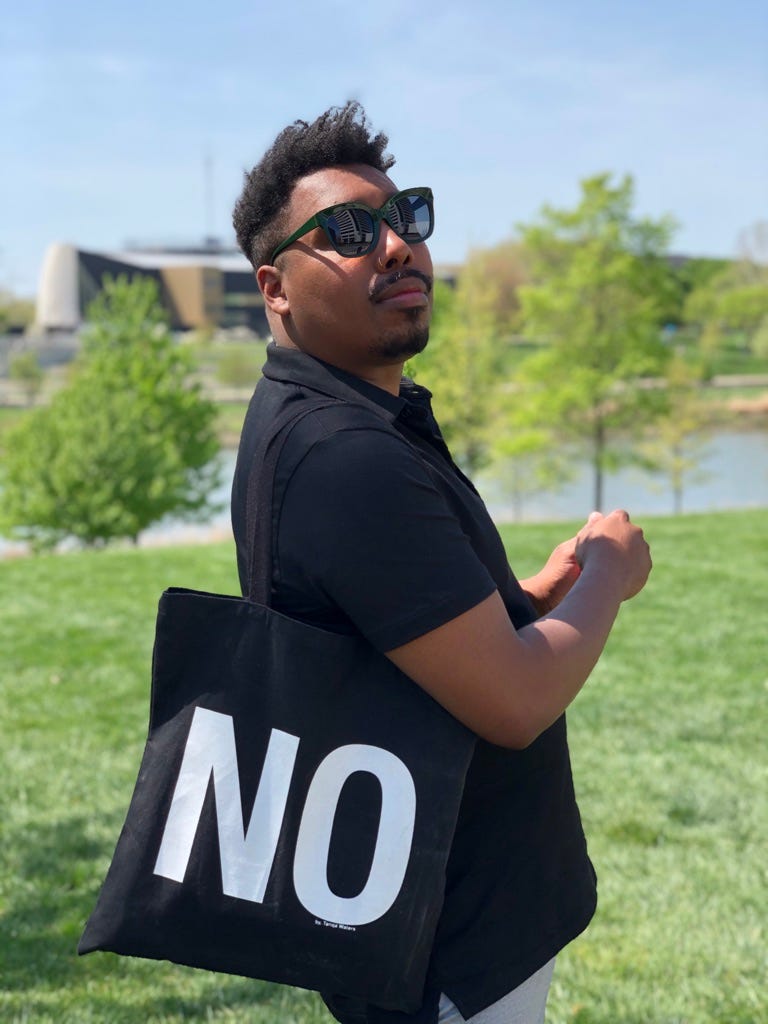

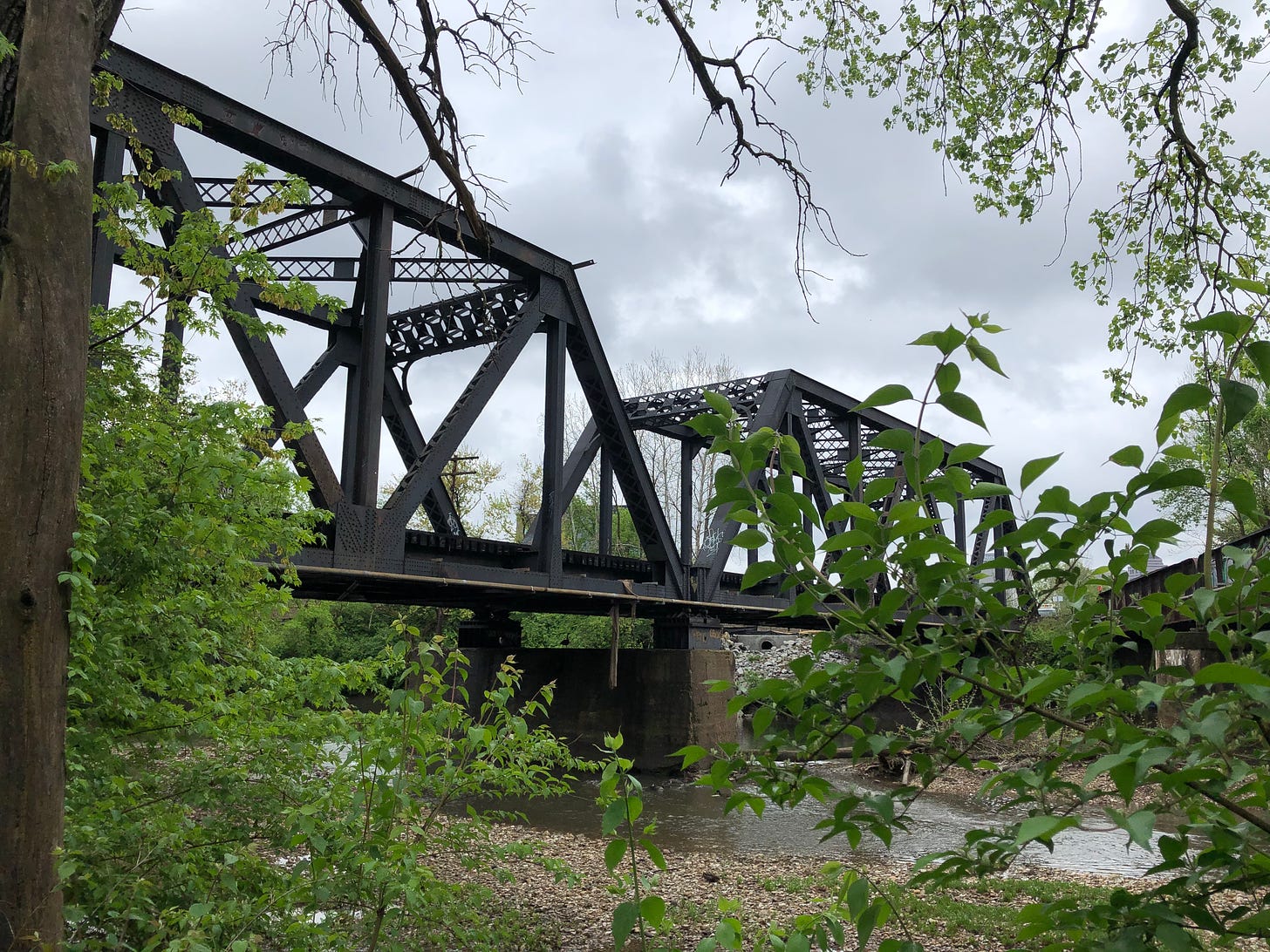
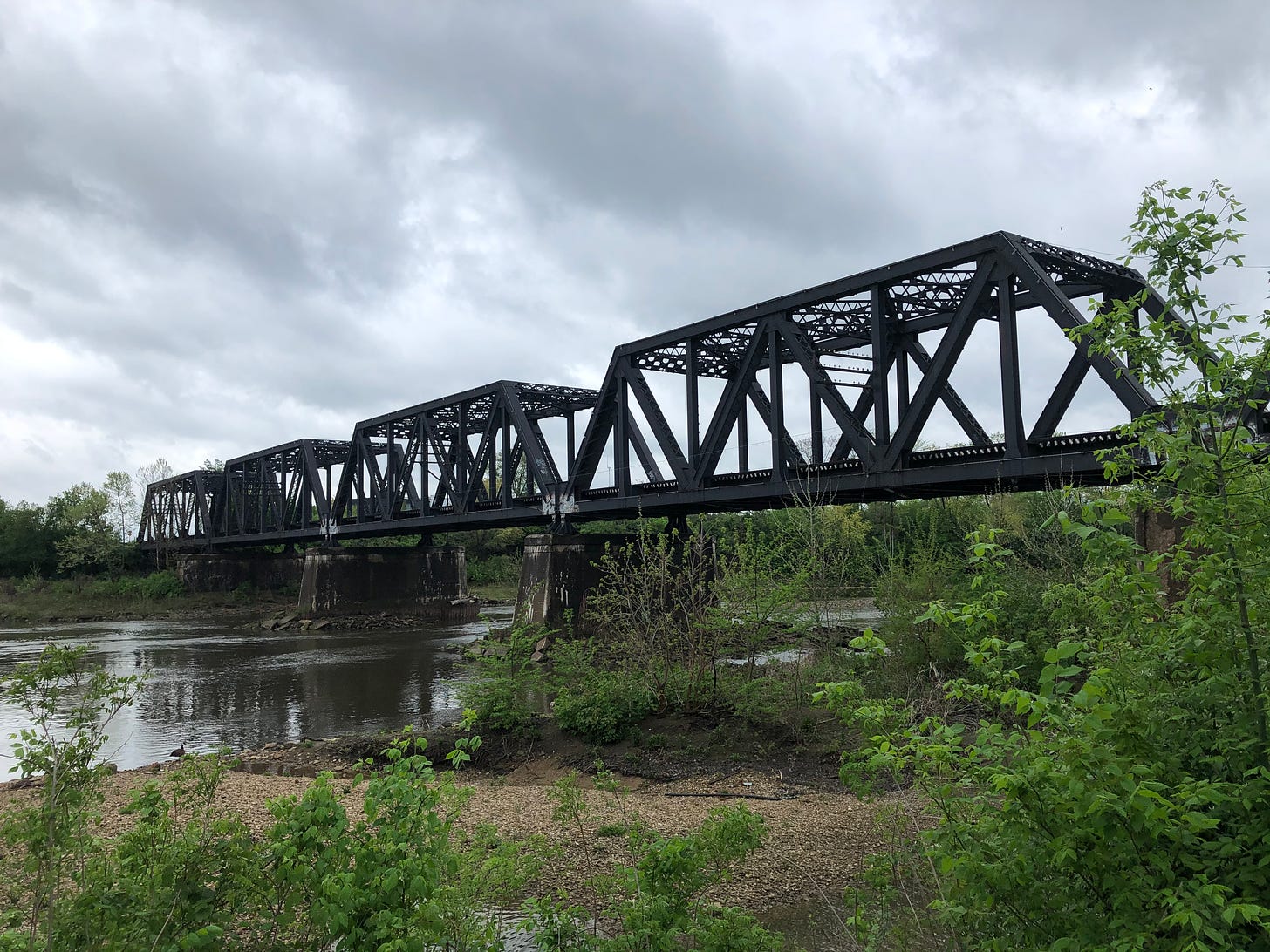
Since I haven't had an opportunity to hear Saeed read his work, this interview is a particular delight. With public life beginning to re-open, I'll anticipate a live reading. It's also reassuring to see a visitor (Isaac) who understands how to appreciate the smaller things that make the city--despite its obvious challenges--a rewarding place to live & create art.
I really enjoyed taking this walk with you and Saeed - and those deer statues are just hillarious! Thanks to Saeed for sharing about his experience in Columbus, activism and friendship. Very inspiring.